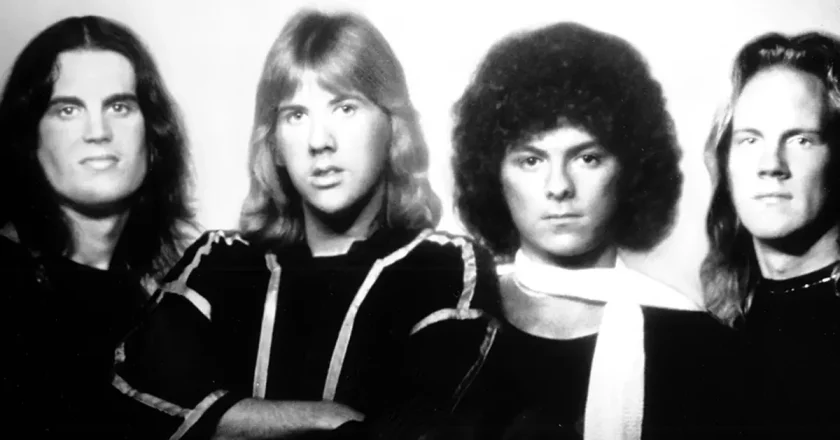Table of Contents
Ambrosia: From Progressive Rock to Soft Rock Stardom
Ambrosia is one of the most versatile and musically sophisticated bands to emerge from the 1970s rock scene. Initially known for their progressive rock compositions, complex arrangements, and rich harmonies, the band later evolved into a soft rock powerhouse, producing some of the era’s most memorable ballads.
Despite this shift in style, Ambrosia’s musicianship remained exceptional, blending elements of progressive rock, jazz, classical, and pop to create a sound that was both intricate and accessible.
This article explores Ambrosia’s formation, their journey from prog rock to soft rock, major albums, and lasting impact.
Formation and Early Years (1970 – 1975)
Ambrosia was formed in 1970 in Los Angeles, California, by a group of highly skilled musicians:
- David Pack – Vocals, guitars, keyboards
- Joe Puerta – Bass, vocals
- Christopher North – Keyboards
- Burleigh Drummond – Drums, percussion
The band took their name from Greek mythology, where “ambrosia” was the food of the gods, a fitting choice for a band that sought to create elevated, sophisticated music.
Early on, Ambrosia gained attention for their complex compositions, intricate vocal harmonies, and progressive influences, drawing comparisons to bands like Yes, Genesis, and The Alan Parsons Project.
Debut Album: Ambrosia (1975) – Progressive Rock Foundations
Ambrosia’s self-titled debut album, released in 1975, was a blend of progressive rock, symphonic elements, and sophisticated pop hooks.
Key Tracks:
- Nice, Nice, Very Nice – Inspired by Kurt Vonnegut’s novel Cat’s Cradle, featuring a mix of poetic lyrics and intricate rhythms
- Holding on to Yesterday – A soulful, progressive ballad that became a minor hit
- Time Waits for No One – A jazz-infused track showcasing the band’s instrumental prowess
- Mama Frog – A complex, time-signature-shifting prog rock piece
The album was co-produced by Alan Parsons, who helped refine the band’s sonic textures and orchestral ambitions.
Despite its progressive leanings, Ambrosia’s debut album managed to gain radio airplay, setting the stage for their commercial breakthrough.
Somewhere Between Prog and Pop: Somewhere I’ve Never Travelled (1976)
Their second album, Somewhere I’ve Never Travelled, expanded on the progressive and symphonic elements of their debut while incorporating a more melodic and accessible approach.
Key Tracks:
- Somewhere I’ve Never Travelled – A dramatic and cinematic piece, showcasing their progressive ambitions
- The Brunt – A complex, jazz-influenced track
- Danse with Me George – A waltz-like composition that displayed the band’s classical influences
This album further cemented their progressive reputation, earning a Grammy nomination for Best Engineered Recording.
However, as the late 1970s approached, musical trends were shifting toward more radio-friendly rock, and Ambrosia was about to undergo a major transformation.
The Shift to Soft Rock Success (1978 – 1982)
Ambrosia’s third album, Life Beyond L.A. (1978), marked a turning point. While the band still retained some progressive elements, they fully embraced a smoother, more pop-oriented sound.
Major Soft Rock Hits:
- “How Much I Feel” – A soulful, heartfelt ballad that became their biggest hit, reaching No. 3 on the Billboard charts
- “Biggest Part of Me” – A silky smooth soft rock classic that defined early 80s adult contemporary music
- “You’re the Only Woman (You & I)” – Another major hit, further establishing Ambrosia’s pop appeal
While this shift alienated some early prog rock fans, it helped the band reach a much larger mainstream audience.
Band Hiatus and Later Years (1982 – Present)
By the early 1980s, internal pressures and shifting musical landscapes led Ambrosia to go on hiatus, with members pursuing individual projects.
- David Pack became a sought-after producer and session musician, working with artists like Kenny Loggins and Michael McDonald.
- Joe Puerta joined Bruce Hornsby and the Range, contributing to their success in the late 1980s.
However, by the 1990s, Ambrosia reunited for live performances, and they have remained a respected touring act, performing both their prog and pop material for dedicated fans.
Why Ambrosia Remains Important in Rock History
✔ Bridging Two Worlds: They successfully transitioned from progressive rock to soft rock, appealing to both art-rock enthusiasts and mainstream audiences.
✔ Sophisticated Musicianship: Even in their poppier material, their harmonies, arrangements, and instrumental skills remained top-tier.
✔ Versatility: Few bands could seamlessly move between prog complexity and radio-friendly melodies like Ambrosia did.
✔ Influence on Later Artists: Their style paved the way for bands and artists blending prog, pop, and jazz, influencing groups like Toto, Asia, and Chicago’s later years.
Conclusion: The Legacy of Ambrosia
Ambrosia’s journey from progressive rock pioneers to soft rock hitmakers is one of the most fascinating transformations in rock history. While they may be best remembered for their soft rock ballads, their early progressive albums remain hidden gems for fans of intricate, ambitious rock music.
For those new to their work, start with Ambrosia (1975) for their progressive side and Life Beyond L.A. (1978) for their softer, more radio-friendly hits.
Whether through prog epics or smooth ballads, Ambrosia left a unique and lasting mark on rock music.





